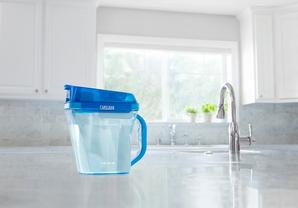By Rhoda Miel
NEWS EDITOR
Published: April 1, 2014 1:39 pm ET
Updated: April 1, 2014 1:46 pm ET

Image By: CamelBak Products LLC
CamelBak's new Tritan and polypropylene filtered pitcher looks to position the company for future growth.
CHICAGO — In early 2008, CamelBak Products LLC launched production of a set of water bottles using Eastman Chemical Co.’s Tritan copolyester.
The bottles were the first commercial product using the resin, which was just introduced a few months earlier, marketed as a replacement for polycarbonate.
Nearly eight years later, Tritan has become the ruling material of the reusable water bottle market industry, selected by housewares companies in response to concerns about bisphenol A.
But what comes next for a resin so well known for bottles?
“What happened was that right off we saw the flywheel go in the sports bottle market first,” said Randy Beavers, global sales director for Eastman during an interview at the International Home + Housewares Show in Chicago, March 15-18. “In 2009, it went into food storage, then in specialty appliances.
“In 2013, we began to penetrate mass market countertop home appliances in a big way.”
Tritan has been used in high-end appliances for a few years, but now it is going into products such as those made by consumer products giant Jarden Consumer Solutions of Rye, N.Y., and well-known brands such as Jarden’s Oster. That means far more volume demands for products sold at internationally-known retailers, rather than specialty shops, he said. Competition from those sales then leads to more sales.
“What we’re hearing from people is that the reason they’re interested in using Tritan is because their competitors are using Tritan,” Beavers said.
And typically the material that Tritan is replacing is not PC, but may be stepping in for styrene acrylonitrile or even glass.
In addition, Beavers said there is increasing interest in Tritan for medical applications, with both medical devices and packaging. The interest there is because Tritan products do not change color, even with the harsh chemicals and heat used during sterilization.
Kingsport, Tenn.-based Eastman is not the only pioneer in Tritan that is adapting to what comes after those first products.
Its partner in that first commercial launch, CamelBak, and other companies have invested a lot of marketing into convincing consumers to carry their own bottles with them. Now Pentaluma, Calif.-based CamelBak is looking bigger, introducing the Relay — a Tritan and polypropylene pitcher with a built-in filter — setting the company to compete with established filtered pitchers including industry leader Brita LP.
The Relay has a dual filter system built into its PP lid, and is designed with a larger opening so water filters almost instantly, said Kristine Weeks, director of marketing. The PP also provides a locking system to keep the lid on tightly.
The Tritan body, meanwhile, is streamlined so it fits into most refrigerator doors. | 